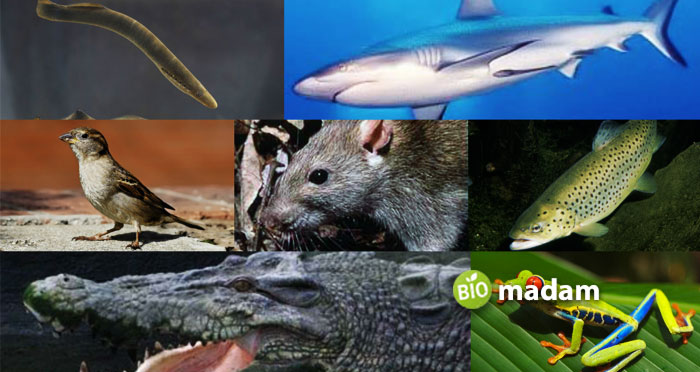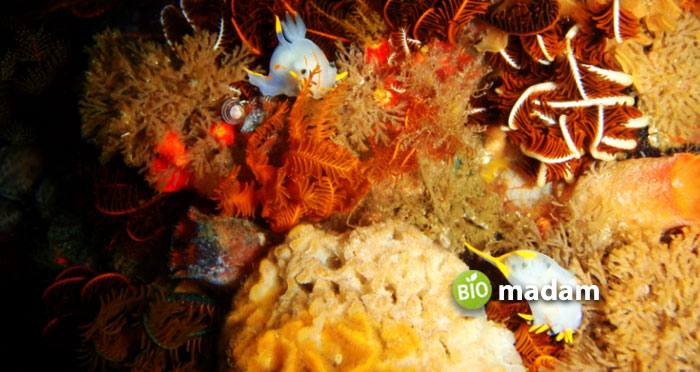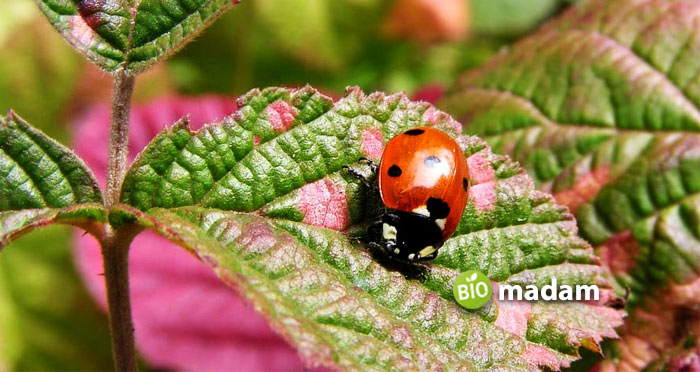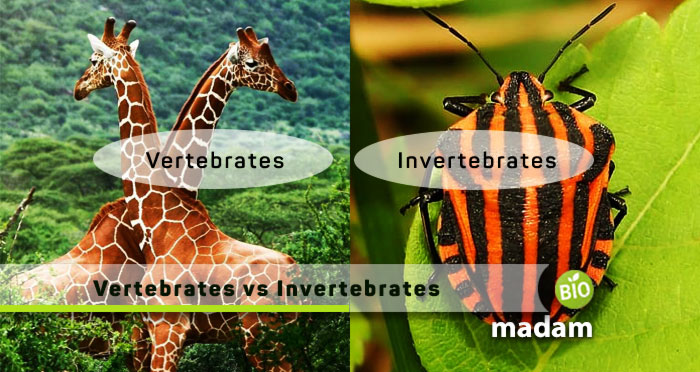Recently updated on March 3rd, 2023 at 10:58 am
Vertebrates and invertebrates are one of the parameters of the classification of animals and help us study their characteristics in-depth. This categorization is based on the presence or absence of vertebrae, also known as the spinal cord or backbone. Animals that possess the spinal cord are called vertebrates, such as humans, whereas those without a backbone are named invertebrates like worms. Besides the backbone, there are numerous other differences between vertebrates and invertebrates as well. Let’s talk about their unique characteristics in detail.
Comparison Table
| Characteristic | Vertebrates | Invertebrates |
| Spinal Cord | Present | Absent |
| Population | 3-5% | 95-97% |
| Classification | Mammals, birds, fish, amphibians, & reptiles | Sponges, jellyfish, crabs, mollusks, insects, etc. |
| Symmetry | Bilateral | Bilateral, radial |
| Size | Huge | Small |
| Structure | Endoskeleton | Exoskeleton |
| Internal Anatomy | Specialized systems | Un-specialized systems |
| Circulatory System | Closed | Open |
| Nervous System | Complex | Simple |
| Skin | Two-layers | Single layer |
| Compound Eyes | Absent | Present |
| Blood Type | Warm-blooded and cold-blooded | Cold-blooded |
| Reproduction | Sexual and asexual | Asexual |
| Nutrition | Heterotrophic | Heterotrophic, parasitic |
| Examples | Humans, elephants | Cockroach, worms |
What are Vertebrates?
Vertebrates are animals with a backbone and belong to the Phylum Chordata. They are highly structured animals with many body parts distinct from this phylum. Their body anatomy and physiology is advanced than many other species and perform specialized functions. Over 58,000 types of vertebrates exist on Earth.
Structure of Vertebrates
Vertebrates have a detailed structure with body functions that may not be present in other animals. They mainly consist of a spinal cord that typically runs through the upper torso in the middle of the body.
The body structure of vertebrates contains the spinal cord, vertebrae, notochord, and mostly a proper endoskeleton. Most vertebrates possess a bony endoskeleton, except fishes with a cartilaginous endoskeleton. The notochord is present in the mid-dorsal line of the body in the embryonic stages. It further develops into the spinal column in adults. Besides vertebrae and notochord, the vascular and respiratory systems are also well-developed in the vertebrates. They have kidneys for excretion of waste materials from the body, and the heart is comparted for enhanced circulatory function and may comprise two, three, or four chambers.
Classification of Vertebrates
Although vertebrates are a sub-group of the Phylum Chordata, these are further categorized into five classes, including:
- Mammals
- Birds
- Reptiles
- Amphibians
- Fish

What are Invertebrates?
Invertebrates are animals that do not possess a spinal cord. The lack of a spinal cord restricts their body to a small size as they might not be able to carry their weight. They are quite commonly distributed in our biome and ecosystem. These are small animals and insects like jellyfish, worms, snails, etc. Their structure is simple compared to vertebrates with less specialized body functions.
Structure of Invertebrates
The structure of invertebrates consists of three main segments; the head, abdomen, and thorax. They do not have an endoskeleton or spinal cord but possess a chitinous exoskeleton. They do not have highly structured systems like the respiratory system and breathe through their skins or gills in some cases.
Classification of Invertebrates
Invertebrates are further categorized into six classes, including
- Mollusks
- Worms
- Arthropods
- Jellyfish
- Sponges
- Starfish

Similarities Between Vertebrates and Invertebrates
- The most important similarity between the two is that they both belong to the kingdom Animalia and have all characteristics of animals.
- Vertebrates and invertebrates are multicellular organisms.
- They both have a nervous system.
- Hearts are present in both vertebrates and invertebrates, though the anatomy may differ.
- They exhibit bilateral symmetry.
Difference Between Vertebrates and Invertebrates
Definition
Vertebrates
Vertebrates are those organisms belonging to Kingdom Animalia that have a spinal cord.
Invertebrates
Invertebrates belong to Kingdom Animalia too but do not have a spinal cord.
Population
Vertebrates
Only 5% of the organisms on Earth are vertebrates.
Invertebrates
Whereas, around 95% of organisms present on the planet are invertebrates.
Classification
Vertebrates
Vertebrates are divided into five classes; mammals, birds, amphibians, reptiles, and fish.
Invertebrates
Contrary, there are over 30 phyla of invertebrates. The common groups of invertebrates are sponges (falling under phylum Porifera), mollusks, jellyfish, orthopods, etc.
Symmetry
Vertebrates
Vertebrates have bilateral body symmetry which means you can cut them into two equal halves.
Invertebrates
However, invertebrates possess a bilateral and radial body symmetry around the central axis, such as in starfish.
Size
Vertebrates
Vertebrates are bigger in size than invertebrates.
Invertebrates
While invertebrates do not grow too big usually as they lack an end structure. Yet, exceptions exist, and some invertebrates may be several feet in size.
Structure
Vertebrates
Vertebrates have a developed internal skeleton and backbone that supports the body structure.
Invertebrates
On the other hand, invertebrates do not have a proper endoskeleton, and the exoskeleton is present.
Internal Anatomy
Vertebrates
They have highly specialized systems like the vascular, including arteries and veins, the respiratory for proper respiration, and the circulatory system for blood circulation.
Invertebrates
At the same time, invertebrates do not have highly-specialized systems or organs like lungs and kidneys.
Circulatory System
Vertebrates
Vertebrates have a closed circulatory system with a heart as the main pumping organ. Some organisms have two-chambered hearts, while others may have three or four chambers.
Invertebrates
On the other hand, invertebrates have an open circulatory system.
Nervous System
Vertebrates
The nervous system in vertebrates is highly complex and further divided into other components.
Invertebrates
Contrary, invertebrates have an unorganized and simple nervous system.
Skin
Vertebrates
The skin of vertebrates is composed of multiple layers of the skin, including the dermis and epidermis.
Invertebrates
In comparison, in invertebrates, only one layer of skin is present to save them from the atmosphere.
Compound Eyes
Vertebrates
Compound eyes are not present in vertebrates.
Invertebrates
However, most invertebrates have compound eyes.
Blood Type
Vertebrates
Most vertebrates are warm-blooded, but they sometimes may be cold-blooded as well.
Invertebrates
Invertebrates are usually cold-blooded.
Nutrition
Vertebrates
As vertebrates belong to the kingdom Animalia, their mode of nutrition is typically heterotrophic.
Invertebrates
Despite belonging to the kingdom Animalia, these organisms may have an autotrophic or parasitic mode of nutrition apart from heterotrophic nutrition.
Examples
Vertebrates
Examples of vertebrates include humans and animals like elephants, zebras, etc.
Invertebrates
Whereas examples of invertebrates are flies, cockroaches, octopuses, bugs, etc.

FAQs
What are dermis and epidermis?
The dermis and epidermis are the two layers that collectively form the skin. The epidermis is the outermost layer of skin, while the dermis is just beneath the epidermis, having several functions.
What are amphibians and reptiles?
Reptiles typically live on land and have a scaly body, while amphibians live in water and on land and have smooth skin. Moreover, reptiles possess lungs for breathing, whereas amphibians have gills that help them stay underwater. Examples of amphibians are frogs and salamanders, and examples of reptiles are lizards, snakes, etc.
How do vertebrates reproduce?
Vertebrates typically reproduce through sexual reproduction, yet some organisms also exhibit asexual reproduction. On the other hand, invertebrates reproduce mainly through asexual reproduction.
Where do invertebrates live?
As insects are commonly invertebrates, they live everywhere around us. You may have many invertebrates like ants, spiders, and flies living in your right now, sharing the same habitat as yours.
The Bottom Line
Vertebrates are animals with a backbone, while invertebrates do not have a backbone. The presence or absence of a backbone in their structure impacts their sizes, and invertebrates are typically smaller in size than vertebrates. Invertebrates also do not have a high structural or functional ability like invertebrates. Many systems are not as well-developed as vertebrates like the circulatory, respiratory, excretory, etc. Both kinds of animals are an essential part of the ecosystem.

Anna has completed her degree in Pharmacy from the University of Hawaii. She is serving as a research assistant in a pharmaceutical company. She had a great interest in writing blogs, traveling to different parts of the US, and trying delicious recipes in her spare time.

